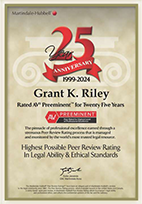
Carbon monoxide (CO) is a silent and invisible killer. It’s colorless and odorless, causing victims to become unconscious before recognizing the classic symptoms of nausea, weakness, and dizziness. A new report indicates carbon monoxide poisoning deaths are rising across the country. Two hundred fifty people died in 2019 from carbon monoxide-related poisoning.
U.S. Consumer Product Safety Commission Report
The U.S. Consumer Product Safety Commission (CPSC) released a report indicating that carbon monoxide poisoning deaths are rising in the United States. The report analyzed carbon-monoxide-related deaths from 2009 to 2019, finding 250 consumer product-related carbon monoxide deaths in 2019 alone. That number represents the most deaths in any year during those ten years. Generators and other engine-driven tools accounted for the largest percentage of deaths.
During that same period, portable generators played a role in 765 carbon monoxide poisonings unrelated to fires. That works out to a staggering 40% of all carbon monoxide deaths attributed to consumer products.
Heating systems were the second most significant cause of carbon monoxide poisoning deaths not involving fires in 2019. The total number was 69 fatalities, or 28% of the total associated with products in this category. The study also shows that more than 50% of all carbon monoxide deaths happen during the typically coldest months of the year—November, December, January, and February. This period is when heating symptoms are in high demand in many parts of the country.
Factors Contributing to the Rise in Carbon-Monoxide-Related Deaths
Several factors may contribute to the rise in carbon monoxide poisoning deaths in the United States, including the following:
- Increased use of portable generators. The demand for portable generators has increased among homeowners and recreational enthusiasts. With more people using them comes more risk, especially when users do not follow proper safety precautions when using a portable generator.
- Lack of public awareness. Many people are still unaware of the dangers of carbon monoxide poisoning. They don’t know what steps they should take to protect themselves and their families.
- Adverse weather. Extreme weather events such as storms, hurricanes, and power outages are becoming more frequent, possibly due to climate change. Because of this, people increasingly rely on portable generators to provide temporary power, potentially increasing the risk of carbon monoxide poisoning.
- Economic factors. The rising cost of living and energy prices may lead some individuals to rely on alternative heating sources, such as portable heaters or stoves, which can emit dangerous levels of CO if misused.
Knowledge is power. The more people understand the dangers of these portable generators and heaters, the more they can protect themselves. Public education campaigns and increased media attention are also necessary to raise awareness.
Preventing CO Poisoning Deaths: Portable Generators
To combat this alarming trend, the CPSC offers several safety precautions to reduce the risk of carbon monoxide poisoning from portable generators:
- Use portable generators outside and at least 20 feet from your home, and direct the exhaust away from nearby buildings.
- You should never operate a portable generator inside—that includes your home, garage, basement, crawlspace, or shed. Despite good intentions, opening doors or windows will not provide sufficient ventilation to prevent lethal carbon monoxide levels.
- Maintain portable generators properly. Always read and follow labels, instructions, and warnings on the generator and in the owner’s manual.
Buying the right generator can also reduce the risk of death. Look for ones with a carbon monoxide shut-off safety feature. This feature automatically shuts the generator off when high levels are detected. Models certified to the latest safety standards, PGMA G300-2018 and UL 2201, are estimated to reduce carbon monoxide poisoning deaths by 87% and 100%, respectively. Another benefit is that UL 2201-certified models also feature reduced CO emissions.
Preventing CO Poisoning Deaths: Heating Systems
In addition to generator safety, it is crucial to prevent carbon monoxide poisoning from heating systems. You should always schedule annual professional inspections of fuel-burning heating products you have at home. Some examples include furnaces, boilers, fireplaces, wood stoves, water heaters, chimneys, flues, and vents. Any of these can lead to accidental carbon monoxide poisoning if misused, improperly installed, or poorly maintained. Defective or blocked venting systems can also result in carbon monoxide poisoning.
If you live somewhere that sees snowfall during the winter, clear snow away from the outside vents of fuel-burning appliances such as furnaces to prevent dangerous carbon monoxide levels from building up inside the home.
Carbon Monoxide Alarms Are Essential for Home Safety
Installing and maintaining carbon monoxide alarms in the home is another critical prevention measure. Ensure alarms are installed on every level of the home and outside sleeping areas. Keep a battery backup for non-battery-operated alarms in case of a power outage. Be sure to test your alarms every month and routinely replace batteries unless you have one with sealed 10-year batteries.
Be mindful of whether alarms are present if you frequently travel, especially staying in an Airbnb or small hotel. If not, bring a portable alarm with you. Several Americans died in Mexico and the Bahamas last year from carbon monoxide poisoning.
Community and Government Actions
Communities and governments should be more concerned with rising carbon-monoxide-related deaths. There are multiple ways they can get involved to help reduce potential deaths, including:
- Supporting public education campaigns that inform and educate people on carbon monoxide dangers and how to protect themselves;
- Implementing stricter regulations on the sales, installation, and maintenance of portable generators and fuel-burning appliances;
- Providing financial assistance to low-income households for installing and maintaining alarms;
- Encouraging the development of new technologies and products that reduce carbon monoxide emissions and improve safety features, such as CO shut-off mechanisms on portable generators;
- Collaborating with local fire departments and other emergency services to conduct regular carbon monoxide inspections in residential areas, especially in areas known for elderly and low-income households; and
- Establishing community-based programs that provide free or low-cost CO alarms and safety checks.
The rise of carbon monoxide poisoning deaths in the United States is a serious concern that demands immediate attention and preventative measures.
Learn More About Carbon Monoxide Safety
Individuals can significantly reduce the risk of carbon monoxide poisoning fatalities by following the CPSC’s safety guidelines, installing and maintaining alarms, and supporting community and government actions. Better education and awareness are also crucial to keep rates from rising. For more information on carbon monoxide poisoning, visit the U.S. Centers for Disease Control and Prevention.
If you lost a loved one to carbon monoxide poisoning, you might have grounds for legal action against one or more parties. At Riley | Ersoff LLP, we have recovered millions of dollars on behalf of carbon monoxide poisoning victims and their families. Call or contact us today to learn more.
The post Deaths on the Rise from Carbon Monoxide in the U.S. appeared first on Riley | Ersoff LLP.


















